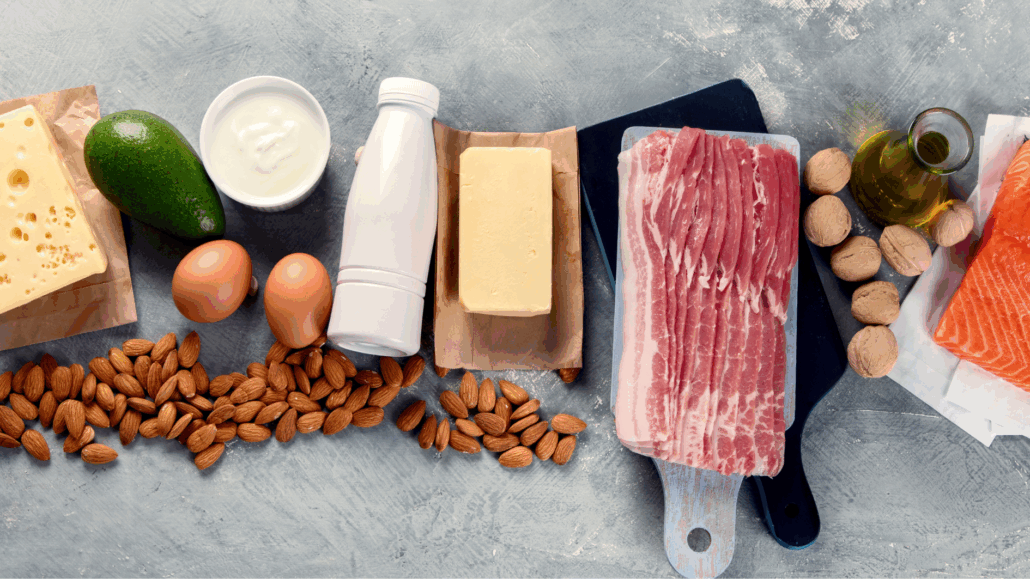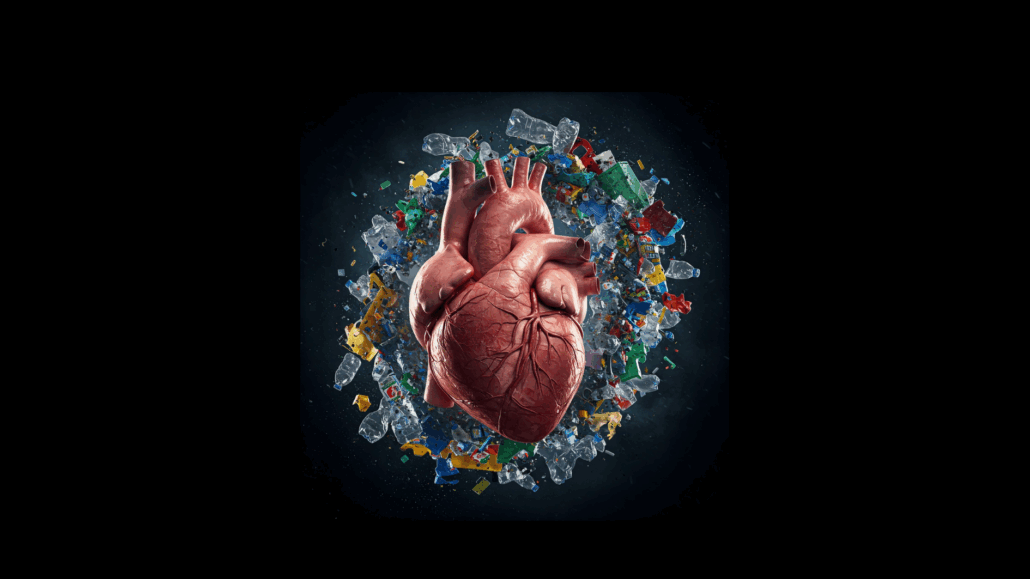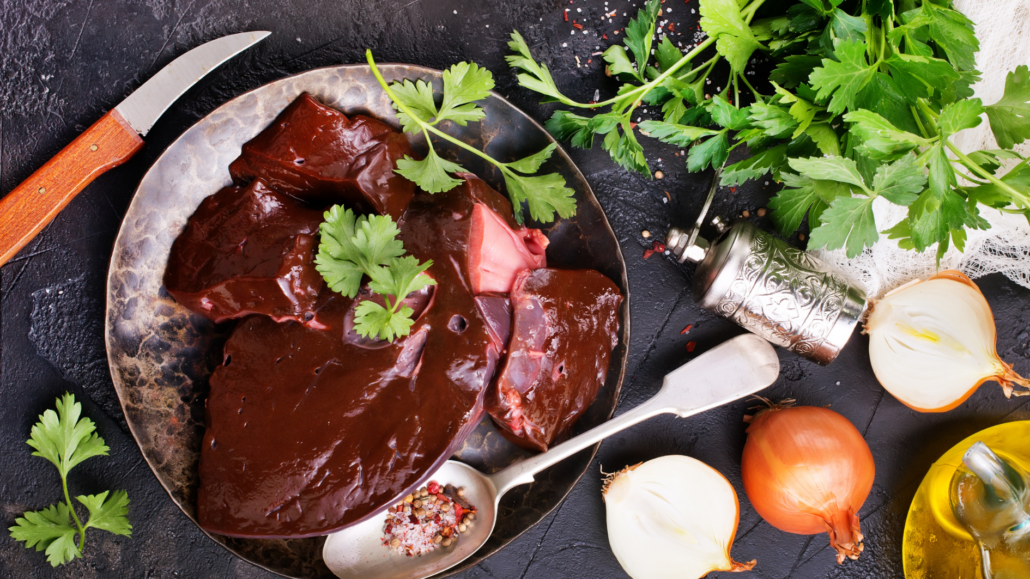We include products in articles we think are useful for our readers. If you buy products or services through links on our website, we may earn a small commission.
What is the Best steak For the Carnivore Diet?
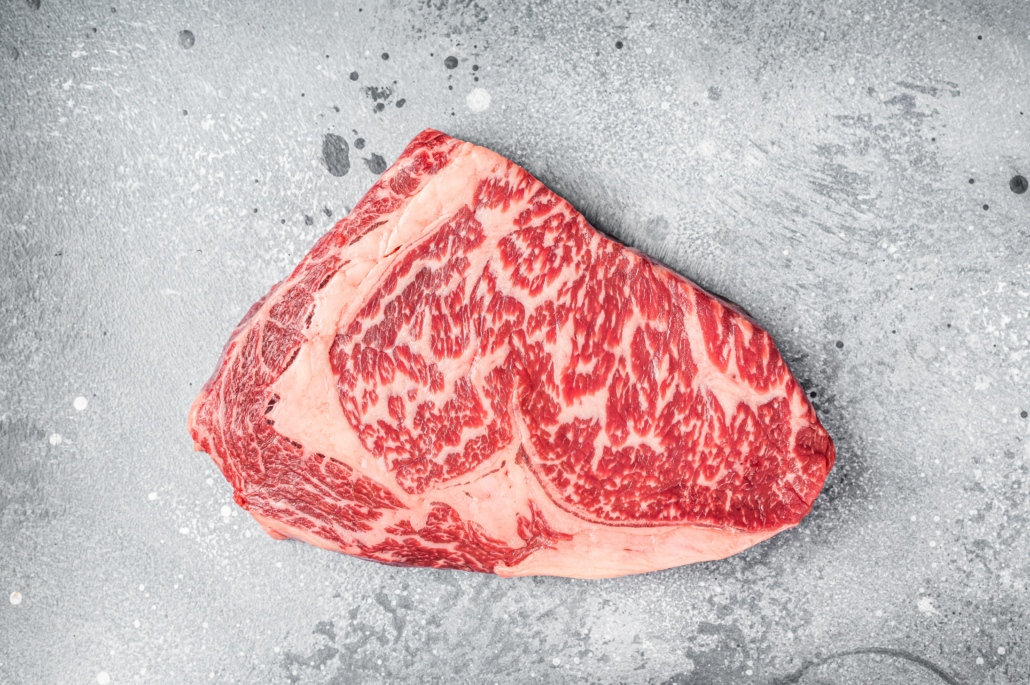
For most carnivore dieters, a well-formulated carnivore diet meal plan is based around succulent, fatty cuts of steak. In fact, there’s a popular approach to eating carnivore that calls for consuming only steak, water, and salt. The primacy of steak on an all-meat diet makes selecting the best steak for the carnivore diet a crucial decision.
In this article, we’ll explore the role of steak on a carnivore diet and determine the best steak to meet this diet’s particular nutritional needs.
Table of Contents
Why Steak on Carnivore
Cows are large ruminant animals that nutritionally resemble the herbivores that our hyper-carnivorous hunter-gatherer ancestors thrived on for nearly two million years.
Our bodies retain the genetic inheritance of our ancestral reliance on fatty meat. A steak-based carnivore diet is a key to realigning our physiology with an ancestral diet in the modern world.
Fatty cuts of steak provide carnivore dieters with a near-perfect complex of macro and micronutrients in the most bioavailable formats. Many of the vitamins, minerals, and compounds in steak are found only in ruminant meat.
Cows have a rumen–the first of four stomachs. This digestive system allows them to process cellulose from plants into a fatty acids profile that is ideal for high-fat, low-carb human diets.
The rumen stomach also helps cows eliminate plant toxins and antinutrients from their plant-based diets. Something humans can’t do themselves. Eating plants exposes us to plant defense mechanisms that can be harmful. This is why Dr. Kiltz likes to say that we humans came out of the trees not to eat the grass, but to eat the grass eaters.
Fatty Steak for Carnivore
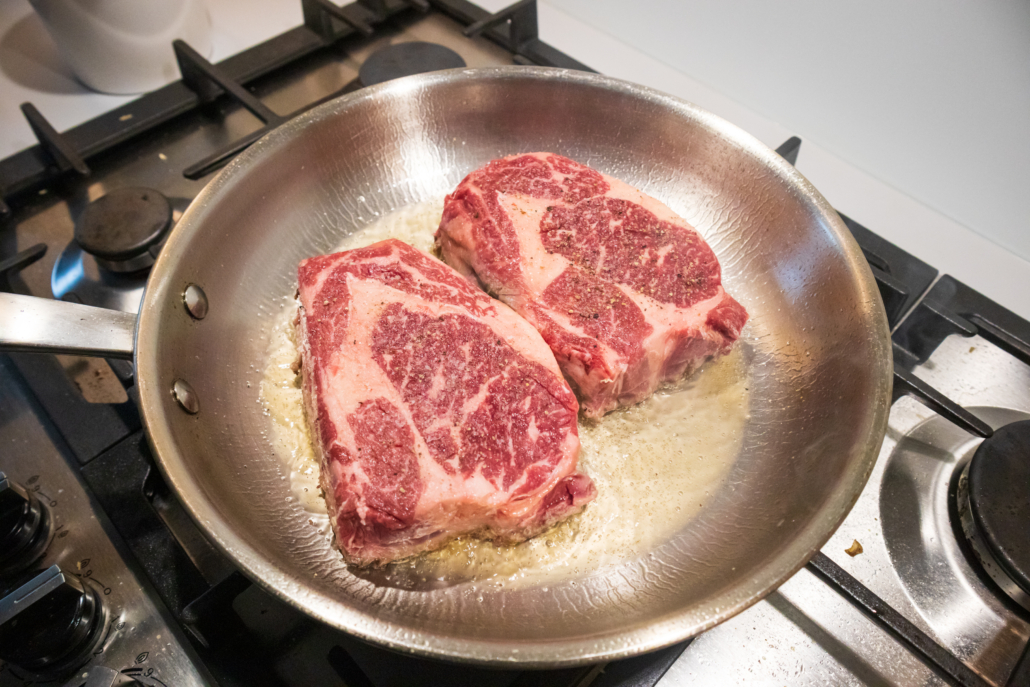
Since most animal products are zero-carb, the carnivore diet is, by default, a high-fat, low-carb way of eating.
As a keto-carnivore eating plan, it’s important that you get enough fat in relation to your protein intake. Most modern humans think of meat as lean muscle meat, but our ancestors thought of meat as primarily fat, with some muscle, along with nutrient-dense organs like liver, bone marrow, and brains.
Our evolutionary focus on fatty animals is preserved in our ability to easily enter ketosis. Over eons as hunter-gatherers, the human body became efficient at using dietary fat for fuel, storing fat on the body for lean times, and breaking it down into powerful energy molecules called ketones.
To maintain a ketogenic metabolic state and avoid overdoing the protein, most carnivore dieters need to consume about twice as many calories as fat compared with protein.
This means that the best steak for the carnivore diet is going to be the fattiest cuts.
The Best Cuts of Steak for The Carnivore Diet
One way to select the best steak on carnivore is to see how closely their macronutrient profile aligns with the optimal carnivore macronutrient intake, which looks like
- 70-80% of calories from fat
- 15-30% calories from protein
- 0-10% calories from carbs
Here’s a list of the fattiest steaks.
Nutrition Info per 100g oz.
| Beef Cut | Calories | Fat | Protein | Carbs | % Calories from fat | % Calories from protein |
| Boneless short ribs | 471 | 42 | 21.6 | 0 | 80 | 20 |
| Ribeye | 411 | 35 | 22.2 | 0 | 77 | 23 |
| Ground Beef (70/30) | 332 | 30 | 14.3 | 0 | 82 | 18 |
| Brisket (Point) | 358 | 28.5 | 23.5 | 0 | 72 | 28 |
| Chuck Roast | 359 | 27.3 | 26.4 | 0 | 68 | 31 |
| Tenderloin | 343 | 26.7 | 24 | 0 | 70 | 30 |
| Ground Beef (75/25) | 293 | 25 | 15.8 | 0 | 77 | 23 |
| New York Strip | 281 | 22.2 | 19 | 0 | 71 | 29 |
| T-Bone | 286 | 20.3 | 24 | 0 | 64 | 36 |
| Ground Beef (80/20) | 254 | 20 | 17.2 | 0 | 71 | 29 |
| Skirt Steak | 255 | 17.1 | 23.5 | 0 | 61 | 39 |
Of course, with the leaner cuts you can boost your fat intake by simply slathering on a few tablespoons of butter, ghee, or beef tallow.
You can also ask your butcher to get any of these cuts “un-trimmed.”
The Best Steak for Carnivore: Ribeye is King!
When considering fat content, nutrient density, and overall carnivorous pleasure, ribeye is king!
Ribeye is one of the most nutritionally complete foods on earth and is loaded with an abundance of bioavailable nutrients that support numerous markers of health, fertility, and longevity
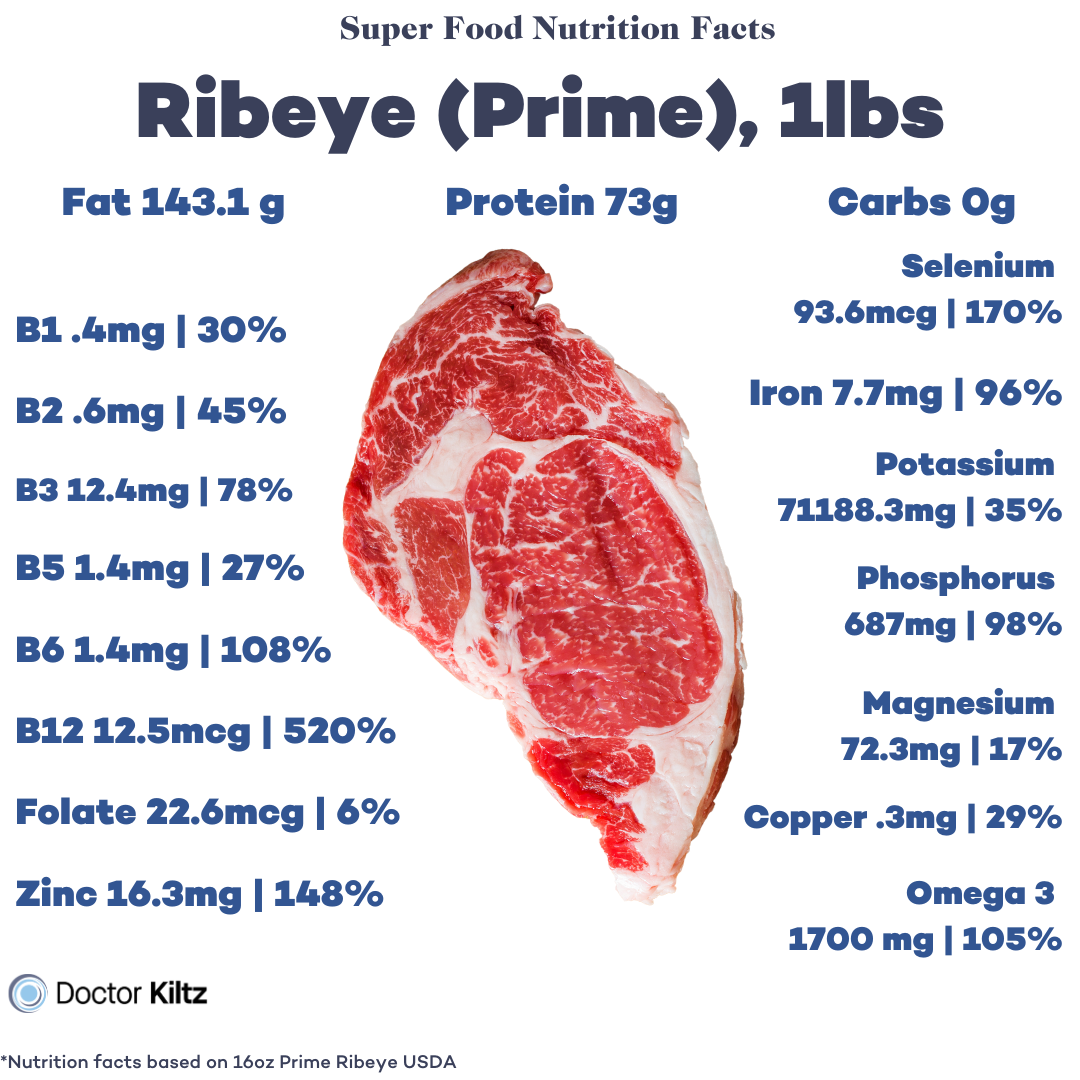
On nutrition labels, you’ll find many key ribeye nutrients like B vitamins, zinc, selenium, vitamin D, and iron. But ribeye is also a source of other vital nutrients like carnitine, creatine, taurine, and carnosine that USDA doesn’t list.
Let’s take a look at what nutrients you’re nourishing yourself with each time you make a 1lb ribeye the centerpiece of your carnivore meals :
| NUTRIENT | 1lbs (16 OZ) | |
| CALORIES | 763 cal | |
| FAT | 42.4g | |
| SATURATED FAT | 16.4 g | |
| MONOUNSATURATED FAT | 18.5 | |
| CARBOHYDRATES | 0 | |
| PROTEIN | 90.6g | |
| VITAMINS | ||
| B1 (THIAMIN) | 55% | |
| B2 (RIBOFLAVIN) | 93% | |
| B3 (NIACIN) | 102% | |
| B6 | 129% | |
| B12 | 484% | |
| MINERALS | ||
| MAGNESIUM | 27% | |
| POTASSIUM | 49% | |
| IRON | 167% | |
| COPPER | 66% | |
| PHOSPHORUS | 144% | |
| SELENIUM | 207% | |
| ZINC | 346% |
Best Steak for Carnivore: Nutrient Highlights
Let’s break some of these nutrients out and learn a bit more about what they’re doing for you.
Conjugated Linoleic ACID (CLA)
Though this is a nutrient you won’t find on a nutrition label, its benefits warrant us calling it out.
A result of the fermenting process that takes place within the ruminant digestive system is the production of a highly beneficial fatty acid called Conjugated Linoleic Acid (CLA).
Fatty cuts like ribeye and New York strip provide an abundance of CLA, which is associated with health benefits, including
- Reduced body fat, increased lean muscle mass
- Reduced risk of atherosclerosis
- Improved immune response
- Reduced symptoms of diabetes
- Increased bone density
The human body cannot manufacture CLA on its own, which means that you need to get it through dietary sources–steak on keto is a prime source.
A four-ounce serving of grass-fed ribeye steak contains up to 430 mcg of CLA.
Stearic and Monounsaturated Fatty Acids
Steak provides other beneficial fats, including stearic acid and monounsaturated fatty acid.
Stearic acid is one of the most prevalent saturated fats in steak. Studies have associated stearic acid with improved mitochondrial function and weight loss.
Another fatty acid that makes up nearly half the fat in a ribeye steak is called monounsaturated fatty acid.
Monounsaturated fat has been shown to
- Reduce inflammation
- reduce bad cholesterol
- increase good cholesterol
- Potentially reduce the risk of heart disease
Micronutrients in Steak
In addition to an abundance of beneficial fats, steak on keto provides numerous vital nutrients, some of which are only found in meat.
- Carnitine: Show to significantly improve male fertility. Protects against anemia. Promotes mitochondrial function and increases insulin sensitivity for people with type 2 diabetes. Reduces risk of heart disease.
- Carnosine: Cardioprotective. Prevents cell and tissue damage caused by sugar intake. Provides anti-aging antioxidant effects that neutralize free radicals and protect telomeres.
- Creatine: Supports cognitive function. Enhances athletic performance. Low levels of creatine are associated with Alzheimer’s disease. Supports cardiovascular health and regulates blood sugar.
- Taurine: A powerful antioxidant that reduces glycation, inflammation, and oxidative stress. Found to have anti-depressive effects in animal studies.
- Zinc: Supports immune function and heart health. A key factor in insulin formation. Increases glycemic control for people with diabetes. [19]. The zinc in steak is 400% more bioavailable than the zinc you get in breakfast cereals. [15] Acts as an anti-depressant. In men, low levels of zinc are associated with lower sperm count and erectile dysfunction.
- Vitamin B12: Only found in animal products. Essential for maintaining a healthy nervous system, the synthesis of DNA, and the production of red blood cells. Deficiency in B12 is associated with dementia and Alzheimer’s disease. [21] A powerful natural antidepressant.
- Heme Iron: Found only in meat. Critical to proper immune function, cognition, and energy metabolism.
Beef Organ Meats
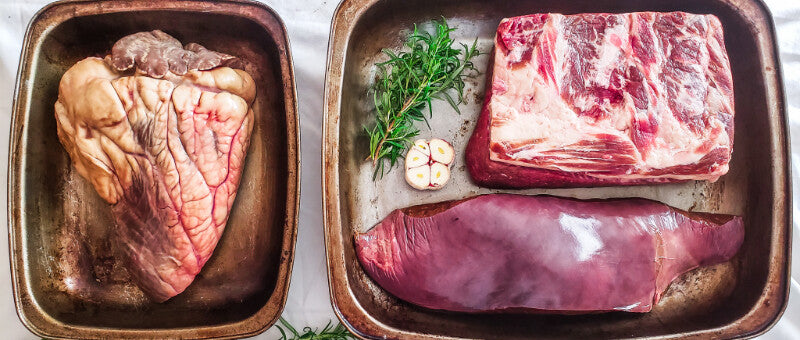
Though you can thrive on a carnivore diet without organ meats, forgoing these natural multivitamins would be selling your nutrition short.
Studies on traditional hunter-gather cultures reveal that they prized organ meats for their robust health benefits.
The revival of nose-to-tail eating has thrust these overlooked morsels into the limelight. Now, it’s fairly easy to find high-quality beef liver loaded with vital nutrients, including vitamin A (retinol), E, K2, vitamin D, and even vitamin C.
Beef liver is so remarkably high in vitamin A that you can only enjoy it a few times a week or you’ll risk vitamin A toxicity.
Other nutritionally potent and surprisingly delicious beef organ meats to incorporate into your carnivore diet include
- Kidney
- Pancreas
- Brain
- Tongue
- Tripe
- bone marrow.
If sourcing and cooking organ meats is too intimidating, beef organ meat supplements may be a good option.
Here’s a peek under the hood of beef liver to see what makes it so nutritionally powerful.
| Beef Liver | ||
| Based on 100 grams | ||
| Calories | 135 | |
| Fat | 3.6g | |
| Protein | 20.4g | |
| Net Carbs | 3.9g | |
| Vitamins | %Daily Value | |
| Vitamin A Vitamin B6 Vitamin B12 Thiamine Riboflavin Niacin Folate Choline Vitamin C Vitamin D Vitamin K | 4968μg 1mg 59.3μg 0.2mg 2.8mg 13.2mg 290μg 333.3mg 1.3mg 1.2μg 3.1μg | 552% 84% 2471% 13% 163% 66% 73% 61% 3% 8% 3% |
| MINERALS | ||
| Iron Magnesium Phosphorus Zinc Copper Manganese Selenium | 4.9mg18mg 387mg 4mg 9.8mg 0.3mg 39.7μg | 62%6% 39% 27% 488% 16% 57% |
Carnivore Diet Bone Broth
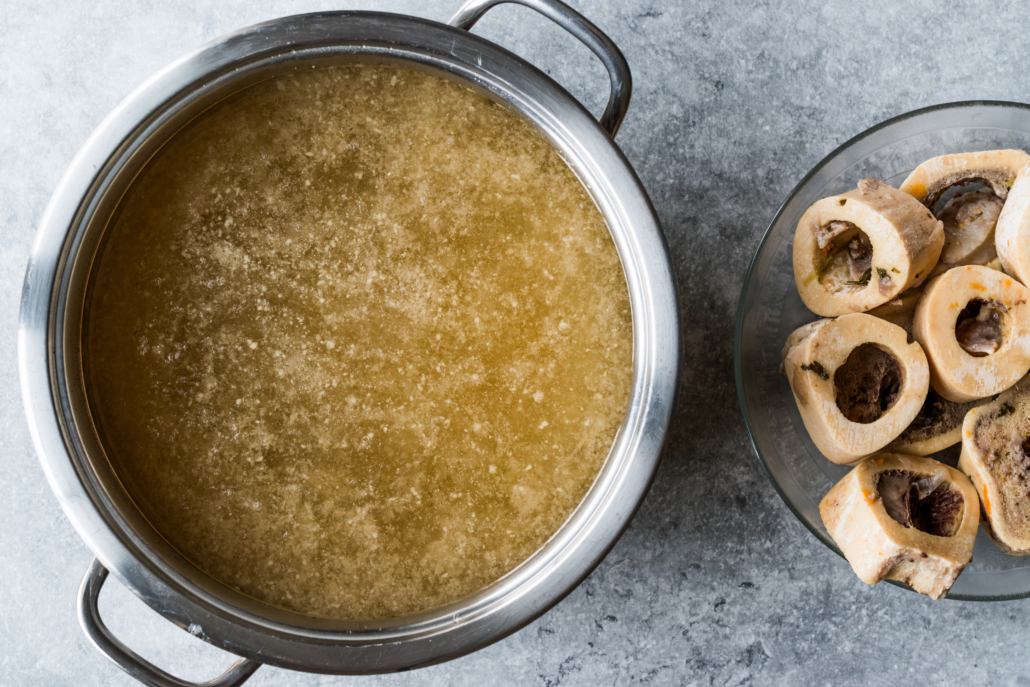
Though not exactly steak, beef bone broth is a staple of many carnivore diets.
It can be especially helpful for boosting electrolytes and staying hydrated when transitioning from a high-carb standard diet. =
Bone broth is also high in a particularly beneficial amino acid called glycine. Glycine helps your body produce the bile it needs to break down the increased fat load that is part of the carnivore lifestyle. This can help alleviate constipation and diarrhea.
Beef Tallow
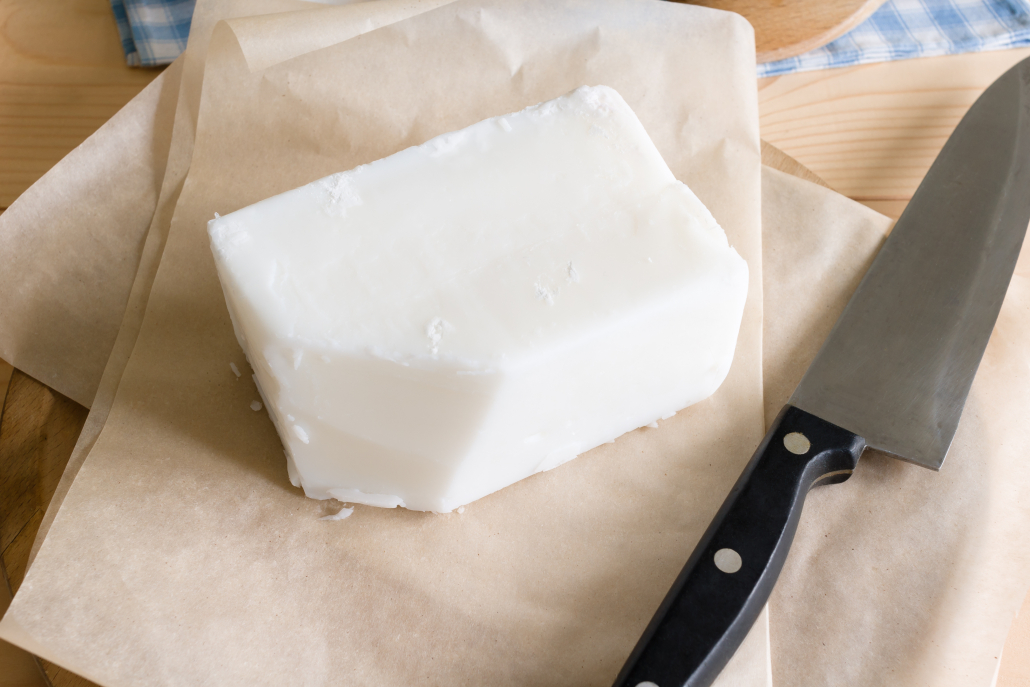
Beef tallow is fat rendered from beef. It’s high in saturated fatty acids, making it resistant to oxidation and great for high-heat cooking.
When Dr. Kiltz enjoys a treat day, he makes homemade tallow-fried french fries.
Tallow is also a good way to increase the fat ratio when eating leaner cuts of steak.
Grass-Fed Steak on Carnivore

Though conventional steak is certainly a healthy whole food that will provide your nutrient needs on carnivore, grass-fed steak is even more nutritious.
Grass-fed steak provides higher concentrations of
- thiamine (B1)
- riboflavin (B2)
- fat-soluble vitamins A, D, E, and K
- Zinc
- Calcium
- Magnesium
- Potassium
- Phosphorus
- heme iron
- Up to 500% more omega-3 fatty acids.
- 200% more CLA than grain-fed beef.
- Much higher in vitamin E, which offers antioxidant protection of cell membranes.
- Higher levels of various other antioxidants.
Best Steak for the Carnivore Diet: The Takeaway
All cuts of steak are excellent nutritionally abundant cornerstones of a carnivore diet. However, ribeye steak provides the greatest abundance of nutrients in near-perfect ratios for our physiological needs. In fact, ribeye is among the healthiest foods to eat in the world.
Ribeye and other cuts of fatty steak provide essential fats and protein and an array of essential micronutrients in formats that are easy for your body to absorb and use.
If you’re in a pinch, a rule of thumb is to choose the fattiest cut of steak available.











